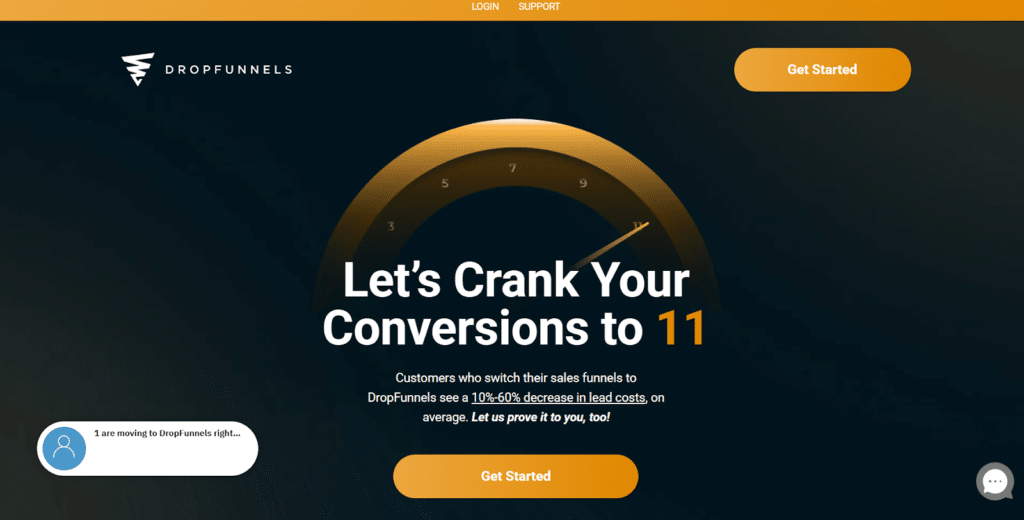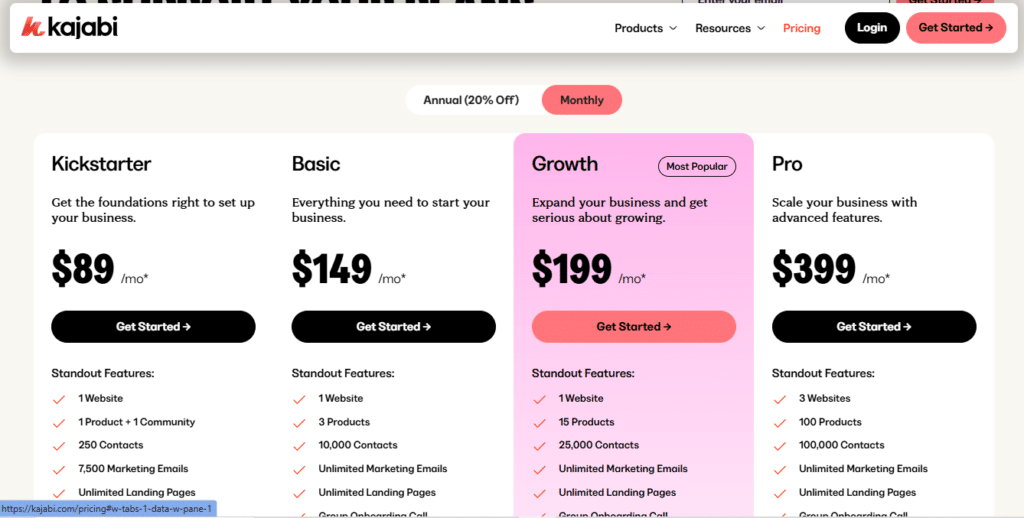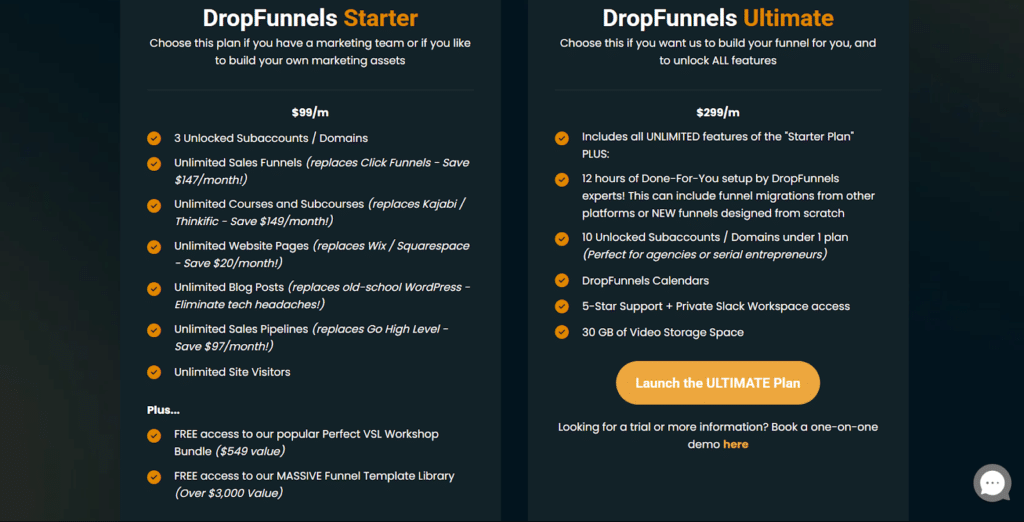Kajabi vs DropFunnels: A Comprehensive Platform Comparison
When building an online business centered around courses, digital products, and marketing funnels, choosing the right platform can significantly impact your growth potential, operational efficiency, and bottom line. Kajabi and DropFunnels represent two different approaches to creating marketing and sales systems for digital entrepreneurs, with Kajabi offering a comprehensive all-in-one business solution while DropFunnels provides a WordPress-based funnel builder with superior SEO capabilities. This detailed comparison will help you determine which platform better aligns with your specific business needs, technical preferences, and long-term goals.
Overview of Kajabi

Kajabi is an all-in-one platform designed for entrepreneurs, creators, and educators looking to build and scale their online businesses. It provides a comprehensive ecosystem for creating, marketing, and selling digital products such as online courses, memberships, and coaching programs—all without relying on multiple third-party tools.
With its integrated website builder, email marketing automation, and sales pipeline creation, Kajabi simplifies the process of running a digital business. Even users with minimal technical knowledge can easily create high-quality content using pre-built templates and intuitive drag-and-drop functionality. By integrating powerful marketing tools with a robust learning management system (LMS), Kajabi enables businesses to efficiently attract, engage, and convert their audience while maximizing revenue—all from a single, user-friendly dashboard.
Key Features of Kajabi
- Course Creation Tools: Develop and deliver engaging online courses with video content, assessments, and drip-fed lessons.
- Website Builder: Design fully responsive, professional websites with built-in blogging capabilities and customizable templates.
- Sales Pipelines: Create automated funnels for lead generation, product launches, and webinars.
- Email Marketing Automation: Send personalized email campaigns, track engagement, and automate follow-ups.
- Membership Capabilities: Set up subscription-based memberships to generate recurring revenue.
- Payment Integration: Securely accept payments via Stripe and PayPal with zero additional transaction fees.
- Analytics Dashboard: Monitor revenue, track customer behavior, and measure marketing performance with in-depth insights.
- Community Features: Build an interactive member space for discussions, engagement, and networking.
Ideal User Base for Kajabi
- Course Creators: Educators and professionals looking to monetize their knowledge through online courses.
- Coaches & Consultants: Those offering coaching services, webinars, and one-on-one mentorship programs.
- Membership Site Owners: Entrepreneurs looking to create thriving subscription-based communities.
- Digital Entrepreneurs: Individuals managing multiple digital products and looking for a streamlined business solution.
Overview of DropFunnels

DropFunnels is a specialized funnel-building platform built on WordPress architecture, designed for digital marketers, course creators, and online entrepreneurs who prioritize search engine optimization (SEO) and page speed in their marketing strategy. Unlike all-in-one platforms that use proprietary systems, DropFunnels leverages WordPress's proven foundation to create marketing funnels with superior SEO capabilities.
What sets DropFunnels apart is its unique combination of funnel building with WordPress's inherent SEO advantages. The platform provides drag-and-drop funnel creation with optimized page speed, built-in blogging, and full SEO control—elements that are often compromised in proprietary funnel builders. By building on WordPress, DropFunnels allows marketers to create high-converting funnels that can also rank organically in search engines, potentially reducing paid advertising dependence.
While not offering the same breadth of features as comprehensive all-in-one platforms, DropFunnels excels in its specific focus: creating lightning-fast, SEO-optimized marketing funnels that leverage WordPress's strengths without requiring technical expertise. For marketers who prioritize organic traffic alongside conversion optimization, DropFunnels represents a specialized alternative to broader business platforms.
Key Features of DropFunnels
- WordPress-Based Funnels: Create marketing funnels built on WordPress architecture with superior SEO capabilities.
- Drag-and-Drop Builder: Design pages and funnels without coding using an intuitive visual editor.
- Optimized Page Speed: Deliver lightning-fast loading times with optimized code and content delivery.
- Built-in Blogging: Leverage WordPress's powerful blogging system for content marketing and SEO.
- Membership Functionality: Create protected content areas with tiered access levels and recurring payments.
- Funnel Templates: Access pre-designed, conversion-optimized funnel templates for various marketing scenarios.
- Affiliate Management: Set up and manage affiliate programs to expand marketing reach.
- Hosting Included: Run your funnels on managed WordPress hosting without additional hosting costs.
Ideal User Base for DropFunnels
- SEO-Focused Marketers: Entrepreneurs who prioritize organic traffic generation alongside paid strategies.
- Content Marketers: Those leveraging content marketing and blogging to drive business growth.
- WordPress Enthusiasts: Users who appreciate WordPress's flexibility and extensibility.
- Funnel Builders: Marketers creating sales funnels, lead generation systems, and conversion paths.
- Advertising-Conscious Entrepreneurs: Business owners looking to reduce long-term advertising costs through SEO.
Core Functionalities Comparison
Understanding the fundamental differences between Kajabi and DropFunnels is essential for determining which platform better aligns with your specific business needs. This section provides a detailed analysis of their capabilities in key functional areas.
1. Platform Architecture and Technical Foundation
Kajabi operates as a fully hosted Software-as-a-Service (SaaS) platform with a proprietary architecture. This approach provides a unified, consistent experience where all components are specifically designed to work together. The platform handles all technical aspects including hosting, security, updates, and maintenance, eliminating technical management for users. While this creates a streamlined experience, it also limits customization possibilities and SEO control compared to open-source solutions. Kajabi's architecture prioritizes ease of use and integrated functionality over technical flexibility or specialized optimization.
DropFunnels is built on WordPress, the world's most popular content management system, providing a foundation with proven reliability and unmatched ecosystem support. By leveraging WordPress architecture, DropFunnels inherits significant advantages in SEO capabilities, content management, and extensibility. The platform operates on managed WordPress hosting (included in subscription costs), handling technical maintenance while still providing the benefits of WordPress's flexible foundation. This architecture offers greater customization potential and SEO control compared to proprietary systems, though it may involve slightly more complexity than fully managed SaaS platforms.
2. Marketing Funnel and Page Building
Kajabi provides integrated funnel building through its “Pipelines” feature, offering pre-designed marketing sequences for scenarios like lead magnets, webinars, and product launches. The platform's page builder uses a block-based approach with drag-and-drop functionality, allowing users to create marketing pages without coding knowledge. Kajabi's strength lies in the seamless integration between funnels, email marketing, and product delivery, creating cohesive customer journeys without requiring multiple tools. While effective for creating standard marketing sequences, Kajabi's funnel building lacks some of the flexibility and optimization capabilities found in specialized funnel platforms.
DropFunnels specializes in funnel building with an emphasis on speed, conversion optimization, and SEO performance. The platform's drag-and-drop builder offers greater flexibility in page design compared to Kajabi, with more customization options and layout control. DropFunnels particularly excels in page speed optimization—a critical factor for both conversion rates and search engine ranking—with consistently faster loading times than most all-in-one platforms. The system includes pre-built funnel templates designed for conversion optimization across various marketing scenarios. For marketers prioritizing funnel performance, page speed, and design flexibility, DropFunnels' specialized approach offers significant advantages despite having fewer integrated features than comprehensive platforms.
3. Search Engine Optimization (SEO) Capabilities
Kajabi provides basic SEO features including customizable page titles, meta descriptions, and URL structures. The platform generates mobile-responsive pages that meet fundamental technical SEO requirements. However, as a proprietary system, Kajabi lacks the depth of SEO control and optimization capabilities found in WordPress-based platforms. Users cannot access advanced SEO settings, schema markup options, or specialized optimization plugins that often drive competitive SEO performance. While adequate for basic visibility, Kajabi's SEO capabilities may limit businesses focusing on organic traffic as a primary customer acquisition channel.
DropFunnels distinguishes itself with comprehensive SEO capabilities inherited from its WordPress foundation. The platform provides complete control over on-page SEO elements, content structure, internal linking, and technical optimization. DropFunnels maintains compatibility with powerful WordPress SEO plugins that enable advanced optimization beyond what proprietary platforms offer. The system's exceptional page speed—a significant ranking factor—further enhances SEO performance. For businesses investing in content marketing and organic traffic generation, DropFunnels' superior SEO capabilities represent a compelling advantage that may significantly reduce long-term customer acquisition costs compared to platforms requiring greater advertising dependence.
4. Course Creation and Membership Management
Kajabi excels in course creation and membership management as core functionalities. The platform offers sophisticated tools for structuring courses with categories, modules, and lessons, supporting various content types including video, audio, quizzes, and downloadable resources. Kajabi's learning environment includes features like drip content scheduling, student progress tracking, completion certificates, and assessment capabilities. The platform also provides robust membership management with different access levels, content protection, and community features. For businesses centered on educational content, Kajabi delivers a comprehensive solution without requiring additional tools or integrations.
DropFunnels includes membership and course functionality, though with less depth than platforms specializing in these areas. The system allows creating protected content areas with different access levels and payment requirements. Users can build basic online courses with standard content types and lesson organization. While functional for straightforward courses and membership areas, DropFunnels lacks the advanced educational features found in dedicated learning platforms like sophisticated assessments, comprehensive student management, or specialized learning tools. The platform's course capabilities are better suited for basic information products or supplementary offerings rather than advanced educational programs requiring specialized learning features.
5. Email Marketing and Automation
Kajabi includes integrated email marketing with broadcast capabilities, automated sequences, and visual automation builders. The platform allows creating sophisticated marketing workflows triggered by user behavior, purchase history, or specific actions. Kajabi's email system supports segmentation based on tags, product ownership, and form submissions, enabling targeted messaging for different audience segments. While not as feature-rich as dedicated email marketing platforms, Kajabi's integrated approach creates seamless connections between email campaigns, products, and website activities without requiring external tools or complex integrations.
DropFunnels does not include native email marketing functionality, requiring integration with third-party email services like ActiveCampaign, ConvertKit, or Mailchimp. The platform provides connection points for embedding forms and triggering actions between the funnel system and external email platforms. This separation requires managing multiple systems and subscriptions but allows using specialized email marketing tools with more advanced capabilities than typically found in all-in-one platforms. For marketers already using dedicated email platforms or those requiring sophisticated email capabilities, DropFunnels' integration approach may provide advantages despite the additional complexity and cost.
6. Blogging and Content Marketing
Kajabi offers basic blogging functionality as part of its website capabilities. Users can create, publish, and manage blog posts with categories, featured images, and essential formatting options. While functional for supplementary content, Kajabi's blogging system lacks the depth and flexibility of WordPress's industry-leading blogging infrastructure. The platform's content management capabilities are designed to support its primary functions rather than serve as a comprehensive content marketing system. For businesses where blogging is secondary to course delivery or membership management, Kajabi's built-in blogging may be sufficient despite its limitations.
DropFunnels leverages WordPress's powerful blogging system, widely recognized as the gold standard for content publishing and management. The platform provides comprehensive blogging capabilities with categories, tags, author management, comments, revisions, and advanced formatting. DropFunnels inherits WordPress's exceptional content organization and SEO capabilities, creating significant advantages for content marketing strategies. For businesses where blogging and content marketing form core components of their growth strategy, DropFunnels' WordPress-based system offers substantial benefits over the more limited blogging capabilities found in all-in-one platforms.
Pricing Comparison: Kajabi vs DropFunnels
Understanding the pricing structures of both platforms is essential for making a cost-effective decision based on your business requirements and budget constraints.
Kajabi Pricing Plans

Kajabi offers several tiered pricing options designed to accommodate businesses at different growth stages:
1. Basic Plan ($149/month)
The Basic Plan is ideal for newcomers to online business. It includes essential tools to get started, such as:
- Support for 3 products and 3 pipelines.
- 10,000 contacts and 1,000 active members.
- Basic marketing automation.
- Unlimited landing pages and emails.
2. Growth Plan ($199/month)
The Growth Plan is perfect for scaling businesses that require advanced marketing features and greater resource limits:
- Support for 15 products and 15 pipelines.
- 25,000 contacts and 10,000 active members.
- Advanced automation and affiliate program management.
- Removal of Kajabi branding for a more customized experience.
3. Pro Plan ($399/month)
The Pro Plan is designed for established businesses with high-volume requirements:
- Support for 100 products and 100 pipelines.
- 100,000 contacts and 20,000 active members.
- Priority support and custom branding capabilities.
- Advanced features such as code editor access for deeper customization.
4. Kickstarter Plan ($89/month)
This budget-friendly option is ideal for beginners who want to test Kajabi's core functionalities before committing to higher-tier plans:
- Limited products and pipelines.
- Basic features for course creation and email marketing.
All Kajabi plans include a 14-day free trial, and users can save approximately 20% by opting for annual billing.
DropFunnels Pricing Plans

DropFunnels provides two distinct pricing tiers with unlimited core features, positioning itself as an all-in-one platform for both websites and sales funnels:
- Starter Plan: $99/month
Ideal for businesses with marketing teams or DIY marketers. This plan includes:
- 3 unlocked subaccounts/domains.
- Unlimited sales funnels, courses, website pages, blog posts, and sales pipelines.
- Unlimited site visitors.
- Access to the Perfect VSL Workshop Bundle ($549 value).
- Funnel Template Library ($3,000+ value).
- Ultimate Plan: $299/month
Geared toward businesses requiring expert assistance and premium features. It includes:
- All Starter Plan features.
- 12 hours of Done-For-You funnel setup or migrations by DropFunnels experts.
- 10 unlocked subaccounts/domains (ideal for agencies or serial entrepreneurs).
- DropFunnels Calendars for scheduling.
- Private Slack workspace for priority support.
- 30 GB video storage space.
DropFunnels’ pricing is competitive, offering unlimited features even in its Starter Plan, making it a budget-friendly alternative for businesses seeking a comprehensive platform.
While DropFunnels may initially appear less expensive than Kajabi, it's important to consider that additional costs may apply for email marketing services, as DropFunnels does not include native email functionality. When factoring in these potential additional expenses, the total cost may be comparable to or exceed Kajabi's pricing depending on your specific requirements and the email marketing service chosen.
Making the Right Choice for Your Business
Choosing between Kajabi and DropFunnels ultimately depends on your specific business model, marketing strategy, and technical preferences. Here's guidance to help you make an informed decision:
Choose Kajabi if:
- You need a comprehensive all-in-one solution that handles courses, marketing, and website in one platform
- Integrated email marketing and automation are essential to your business strategy
- You prefer maximum simplicity and don't want to manage multiple platforms
- Advanced course delivery and membership management are central to your business model
- You value having everything under one roof with unified reporting and management
- Technical simplicity is more important to you than customization or SEO optimization
- Your marketing strategy focuses more on direct response than content marketing or SEO
- You prefer not to deal with WordPress management, even in a simplified form
Choose DropFunnels if:
- SEO and organic traffic generation are significant components of your marketing strategy
- Page speed and conversion optimization are top priorities for your business
- You appreciate WordPress's content management and blogging capabilities
- You already use a separate email marketing platform that you're happy with
- You need greater customization flexibility than most all-in-one platforms provide
- Your business model centers on marketing funnels with supplementary courses or memberships
- You're comfortable with a multi-platform approach to gain specialized capabilities
- You prefer WordPress-based systems for their extensibility and familiar interface
Consider a Hybrid Approach if:
- Your business has complex needs that no single platform can fully address
- You want to leverage each platform's unique strengths without compromise
- You have the technical comfort or team resources to manage multiple integrated systems
- The combined value justifies the investment in both platforms
Some businesses effectively use DropFunnels for marketing funnels and SEO-driven content while using Kajabi or another specialized platform for their core course delivery and membership management. While this approach increases complexity, it can provide “best of both worlds” capabilities for businesses with specific requirements.
Final Considerations
When making your decision, consider these additional factors:
Marketing Strategy Alignment:
Your platform choice should align with your primary customer acquisition channels. If paid advertising dominates your strategy, Kajabi's integrated approach may be ideal. If you're investing in content marketing and SEO for long-term traffic generation, DropFunnels' WordPress foundation offers significant advantages.
Technical Comfort Level:
While DropFunnels simplifies WordPress management considerably, it still requires somewhat more technical comfort than fully managed SaaS platforms like Kajabi. Honestly assess your technical capabilities or team resources when making your choice.
Long-Term Cost Structure:
Consider not just the platform subscription costs but the total business expense picture. DropFunnels may require additional email marketing services but could potentially reduce long-term advertising costs through better SEO performance. Kajabi's higher price includes email marketing but may necessitate greater ongoing advertising expenses if SEO performance is limited.
Growth Trajectory:
Consider not just your current needs but your projected growth over the next 2-3 years. Platform migrations become increasingly difficult as your business grows, so choosing a platform that aligns with your long-term vision is important for sustainable growth.
Both platforms represent valid approaches to building an online business, but they serve different business models and marketing philosophies. By carefully evaluating your specific needs, marketing strategy, and technical preferences, you can select the platform that will best support your unique business journey.